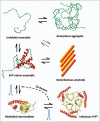Generation of prions in vitro and the protein-only hypothesis
- PMID: 20448454
- PMCID: PMC2933051
- DOI: 10.4161/pri.4.2.11960
Generation of prions in vitro and the protein-only hypothesis
Abstract
Prions are self-propagating proteinaceous infectious agents capable of transmitting disease in the absence of nucleic acids. The nature of the infectious agent in prion diseases has been at the center of passionate debate for the past 30 years. However, recent reports on the in vitro generation of prions have settled all doubts that the misfolded prion protein (PrP(Sc)) is the key component in propagating infectivity. However, we still do not understand completely the mechanism of prion replication and whether or not other cellular factors besides PrP(Sc) are required for infectivity. In this article, we discuss these recent reports under the context of the protein-only hypothesis and their implications.
Figures

Similar articles
-
Generation of genuine prion infectivity by serial PMCA.Vet Microbiol. 2007 Aug 31;123(4):346-57. doi: 10.1016/j.vetmic.2007.04.004. Epub 2007 Apr 7. Vet Microbiol. 2007. PMID: 17493773
-
Kosmotropic anions promote conversion of recombinant prion protein into a PrPSc-like misfolded form.PLoS One. 2012;7(2):e31678. doi: 10.1371/journal.pone.0031678. Epub 2012 Feb 9. PLoS One. 2012. PMID: 22347503 Free PMC article.
-
Liquid-liquid phase separation of full-length prion protein initiates conformational conversion in vitro.J Biol Chem. 2021 Jan-Jun;296:100367. doi: 10.1016/j.jbc.2021.100367. Epub 2021 Feb 2. J Biol Chem. 2021. PMID: 33545172 Free PMC article.
-
The structure of human prions: from biology to structural models-considerations and pitfalls.Viruses. 2014 Oct 20;6(10):3875-92. doi: 10.3390/v6103875. Viruses. 2014. PMID: 25333467 Free PMC article. Review.
-
Prions: a model of conformational disease?Pathol Biol (Paris). 2014 Apr;62(2):96-9. doi: 10.1016/j.patbio.2014.02.003. Epub 2014 Mar 20. Pathol Biol (Paris). 2014. PMID: 24656441 Review.
Cited by
-
Lipid-dependent generation of dual topology for a membrane protein.J Biol Chem. 2012 Nov 2;287(45):37939-48. doi: 10.1074/jbc.M112.404103. Epub 2012 Sep 10. J Biol Chem. 2012. PMID: 22969082 Free PMC article.
-
The extent of protease resistance of misfolded prion protein is highly dependent on the salt concentration.J Biol Chem. 2014 Jan 31;289(5):3073-9. doi: 10.1074/jbc.M113.513267. Epub 2013 Dec 12. J Biol Chem. 2014. PMID: 24338008 Free PMC article.
-
Misfolded protein aggregates: mechanisms, structures and potential for disease transmission.Semin Cell Dev Biol. 2011 Jul;22(5):482-7. doi: 10.1016/j.semcdb.2011.04.002. Epub 2011 May 5. Semin Cell Dev Biol. 2011. PMID: 21571086 Free PMC article. Review.
-
New views on the complex interplay between degeneration and autoimmunity in multiple sclerosis.Front Cell Neurosci. 2024 Aug 5;18:1426231. doi: 10.3389/fncel.2024.1426231. eCollection 2024. Front Cell Neurosci. 2024. PMID: 39161786 Free PMC article.
-
Amyloidogenic cross-seeding of Tau protein: Transient emergence of structural variants of fibrils.PLoS One. 2018 Jul 19;13(7):e0201182. doi: 10.1371/journal.pone.0201182. eCollection 2018. PLoS One. 2018. PMID: 30024984 Free PMC article.
References
-
- Prusiner SB. Novel proteinaceous infectious particles cause scrapie. Science. 1982;216:136–144. - PubMed
-
- Aguzzi A, Calella AM. Prions: protein aggregation and infectious diseases. Physiol Rev. 2009;89:1105–1152. - PubMed
-
- Aguzzi A, Polymenidou M. Mammalian prion biology: one century of evolving concepts. Cell. 2004;116:313–327. - PubMed
-
- Soto C, Castilla J. The controversial protein-only hypothesis of prion propagation. Nat Med. 2004;10:63–67. - PubMed
Publication types
MeSH terms
Substances
Grants and funding
LinkOut - more resources
Full Text Sources
Research Materials
Miscellaneous
